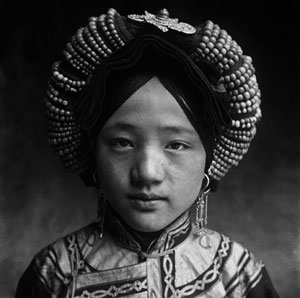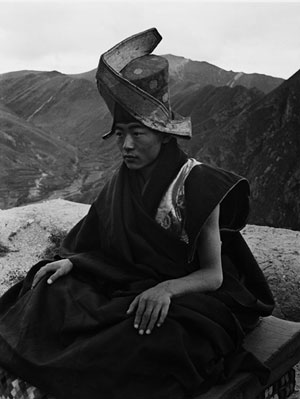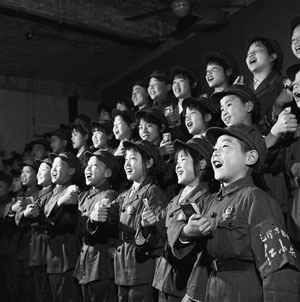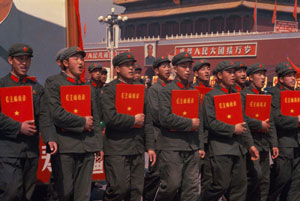Ethnography, Photojournalism and Propaganda, 1934-1975
This is the first of three essays devoted to FotoFest’s current biennial program, Photography from China, 1934-2008. Next week’s article will examine the Independent Documentary Photography, 1985-2008 exhibitions and on April 4, we will cover Staged and Conceptual Work, 1994-2008.

ZHUANG Xueben (1909-1984)...Tibetan Minority Girl in Jiareng Li County...Sichuan Province, 1934...Courtesy of ZHUANG Wenjun
On the eighth day of FotoFest’s citywide program of historic and contemporary photography from China, reports of anti-Chinese riots in Tibet dominated the news and the central themes of FotoFest’s Photography from China: 1934-2008 seemed uncannily prescient. The exhibitions, which are spread across the city, grapple with the very issues that journalists are currently attempting to unravel, including the ethno-political tensions between China and Tibet; China’s totalitarian control of the news media and its skeleton-packed closet. As China attempts to exist comfortably in its recently won role of global superpower, all the feats of economic domination and public relations mastery prove unable to silence the years of alternately noble and treacherous history.
Even viewers hardwired for an exclusive appreciation for contemporary art would do well to see the China exhibitions chronologically. The history of photography in China is so unlike the European/American trajectory that diving into the most recent work without a sense of its political and aesthetic development is a recipe for confused ambivalence. While some of the contemporary work initially seems either densely coded or artistically half-baked, tracing the unique lineage of photography’s unlikely adventure in China (which involves episodes of deathbed homicide; handmade knockoff Hasselblads; camel rides to unmapped, slave-trading regions; contraband negatives ferreted away from Maoist broadsheets; post-Tiananmen Square underground photo-theory zines; and pixilated crotch-shots) is the key to unlocking China’s most recent movements.
FotoFest begins its historical programming not in 1839, but almost 100 years later, with Zhuang Xueben’s ethnographic portrait of the country’s most remote regions. The Chinese were not what we’d call “early adopters” of photography. Ruled by imperial dynasties until 1912, China largely rejected photography until the early 20th century, when two modes of photography gradually emerged: formal studio portraiture and saccharine, Pictorial-influenced nature scenes. Insulated from Western art of nearly every variety (to say nothing of avant-garde photography), once the Chinese finally embraced the medium, they essentially used it to make traditional Chinese landscape paintings.
This procession of frankly quotidian images was jolted into remarkable focus by Zhuang Xueben, a self-taught photographer possessed with a deep sense of national pride and an even deeper case of wanderlust. In the early 1930s, when Japan was beginning its invasion of China, Zhuang set out on camel and foot through the unmapped no-man’s-land of southwest China. The photographer was intent on seeing Tibet and photographing its people, who were “slandered as uncivilized savages, with disheveled hair, dressed in leather, eating raw meat, and sleeping in open wild fields,” according to Zhuang’s son. Finally reaching the politically turbulent country, Zhuang was denied entry; meanwhile, his hometown of Shanghai was under Japanese occupation, leaving the young photographer little option but to survive China’s “uninhabited land” for over ten years.

ZHUANG Xueben (1909-1984)...Tibetan Buddhist Monk, Living in Heaven...and giving Light to the Soul, Yu Shu County...Qing Hai Province, 1937...Courtesy of ZHUANG Wenjun
Ethnography, Western China 1934-1939 is a moving and remarkable visual record of Zhuang Xueben’s decade among the indigenous people of China’s uncharted western provinces. During his ten years in nomadic exile, Zhuang lived among the 16 minorities there, discovering, of course, that they were hardly the savages of the Chinese popular imagination. His portraits affectionately depict an uncommonly serene and self-possessed people—few of whom, we can presume, had ever seen a camera before.
Unlike the mawkish, fuzz-toned nature shots being made in Shanghai and Beijing, Zhuang’s images are startlingly direct and modern. The FotoFest show is split between portraiture and documentary scenes of daily life in the villages. This latter category is particularly stunning: The regions’ towering, snow-draped mountains provide dramatic backdrops for vistas of thatched monasteries that appear to grow organically out of the valley floors. The black yaks which pepper the stark white tundra appear almost hallucinatory in their casual physicality, and the Tibetan herders who huddle in their tent seem entirely unconcerned with the presence of a foreign cameraman in their home. To Zhuang’s enormous credit, it is nearly impossible to imagine this world—much less these photographs—in color. These pictures are not taken from the world; they exist within their own framework.
Zhuang’s compassionate eye is evident in candid photographs of mourning Tibetan monks at a hillside funeral. The somber, robed men cast their eyes off camera, their faces drawn with stoic sorrow. Among them, a buzzard rests his wings, gazing out upon the valley with the monks. His curved, featherless crown mimics the monks’ shaved heads, and the shapelessness of the monastic robes is mirrored in the bird’s inelegant body.
The setup is ripe for a visual gag, Elliot Erwitt or Martin Parr style, but Zhuang is uninterested in ironic caricature. Rather, he deftly manages with an enormous sense of dignity to compare the holy men to a buzzard. In this quiet moment of visual and spiritual harmony between man and beast, it is not enough for the bird to relax in proximity to the peaceful men. Instead, the buzzard appears to mourn with them, or at the very least, to respect their grief by contemplatively sharing the view.
Zhuang’s portraits are perfect complements to his documentary images, although they raise stickier questions about photographic practice and intentionality. In advance of his unrealized journey to Tibet, the Chinese government asked Zhuang to make anthropological portraits of the ethnic minorities there—to measure and photograph their heads for scientific “analysis.” This method of ethnographic study and portraiture was widely used in the 19th century to propagate pseudo-scientific “proof” of racial superiority. It is immediately evident, however, that the photographer admired his subjects far beyond any scientist/specimen level of objectification.
There’s no sense of malice in any of these portraits, due in large part to the sitters’ participation in balancing the dynamics of power between observer and observed. The sitters face the camera with a directness that, in most historical examples, tends to betray one of two distinct attitudes toward the photographer— total spiritual subjugation or barely suppressed defiance. The power of Zhuang’s portraits, however, stem enormously from the self-assured stillness the indigenous people convey with their patient, direct eye contact. This relationship of reciprocity falters, however, once the gaze is broken.
Two profiles of young women are included in the exhibition, allowing us to admire their ornate headdresses, which are visually hoisted by sweeping rushes of black hair cresting over their curved necks. It is only at this point that we notice their faces, eyes averted towards the ground. By having to turn away from the lens, the spell is broken, and the two women look utterly chastened by the camera’s slightly elevated stature. The melancholy of these one-way portraits returns the viewer to the political and cultural realities that prompted their creation. The hillside monks may have been able to coexist harmoniously with wild buzzards, but the brief intrusion of photographic modernity and otherness exerts a pressured strain that’s immediately evident in the profiles of these dignified people.

Sha Fei (1912-1950)...Militia women training in how to throw hand grenades...1940...Courtesy of WANG Yan
There’s no ethno-political ambiguity, however, in Sha Fei’s photographs from The Northern Front, the Anti-Japanese War 1937-1946. When the Japanese invaded China in 1937, Sha Fei immediately enlisted for battle and was sent to the region that housed the Communist (CCP) military headquarters. Famously declaring that “photography is a weapon,” Sha Fei helped to establish Communist newspapers that perpetuated violently anti-Japanese sentiment and celebrated the Communist heroics.1 He organized photography exhibitions in frontline trenches and tirelessly published and distributed his form of journalism—even sending anti-Japanese photos and newspapers to the enemy. He also trained other photojournalists and soon had nearly 1,000 shooters working for him, all of whom meticulously archived, preserved and catalogued their negatives as per Sha Fei’s organizational system. His battalion of photographers used aviation film in their cameras when supplies got low, exposed their prints in the sunlight and withstood several attacks from the Japanese army.
The drama of Sha Fei’s story, however, pales next to his photographs, which read like illustrations from an action-adventure book. (That effect is easier to achieve, it’s worth noting, when the photographer is uninterested in the moral ambiguities and ethical underpinnings of war.) I felt myself silently rooting for the scrappy CCP army in his images—admiring the devotion of the women who packed homemade grenades, the patient precision of the riflemen lying in wait, and the diligence of the soldiers as they went through seemingly endless maneuvers and drills. If generating sympathetic pride for the Chinese army was the express goal of Sha Fei’s photography, I cannot deny his mastery.
Further blurring the lines of journalism and propaganda, truth and fiction, many of his photographs depict training exercises, although they carry the visual drama of actual battlefield photographs. An incredible picture from 1943 shows artillerymen carrying out drill maneuvers with a live cannon. Sha Fei made the picture just as the massive weapon fired, kicking up a small storm of dust in its wake and rattling the earth just enough that the photograph sports a gritty blur of dynamic intensity. In fact, with the crisp details usually afforded by photography missing, the hazy atmospherics of the shell-shocked terrain and the intense tonal play between earth and sky, the image looks like nothing so much as one of David Levinthal’s miniature battle scenes from Hitler Moves East. The more precise analogy, however, is to An-My Lê’s contemporary photographs of battlefield training grounds and wartime recreationists. While the Sino-Japanese war resulted in millions of real casualties, Sha Fei’s photographs contain an element of fiction resulting from his devotion to the predetermined narrative.2

Sha Fei (1912-1950)...The Front-Training exercises in cutting barbed wire...1943...Courtesy of WANG Yan
One of the most significant images is also one of the quietest. It’s an almost patently absurd photograph that, like Zhuang Xueben’s scene of the monks and buzzard, sidesteps caricature to reveal a deeper truth. Several soldiers are clustered in a foxhole, as two artillerymen keep their positions, eyes peeled on the horizon for any sign of attack. The trenchmen are more relaxed and are gathered around a Communist newspaper, undoubtedly illustrated with photographs by Sha Fei. The image is a powerful demonstration of the pragmatic, military role that media served, telling the world that the soldiers considered knowledge gathering as tantamount as running drills. This image, if not expressly composed as a living, advertorial endorsement for the newspaper, was at minimum an extremely fortuitous opportunity for the photographer to illustrate his own importance. But, skilled propagandist that Sha Fei was, this skin of manipulation is subtle enough to become nearly invisible.
The legacy of Sha Fei’s “photography as weapon” mentality and the social impact of his pro-Chinese images cast a long shadow in the photographer’s homeland, including its direct theoretical, if not visual, influence on the Cultural Revolution (1965-1975). Under Chairman Mao’s reign, Maoist photography was Chinese photography, as any activity (particularly photography) that did not directly contribute to the collective good or otherwise exalt the dictator was strictly forbidden. The only photographers during this era were government employees who turned their film in to bureaucratic editors, who published the most politically pleasing images.
This arrangement provided the entirety of photographic activity in China for a full decade. FotoFest’s Cultural Revolution, 1965-1975 highlights the work of three media photographers from the era, all of whom worked for small newspapers where they were able to covertly smuggle their negatives home from the provincial offices. The works of Weng Naiqiang, Xiao Zhuang and Wang Shilong are not only extremely rare, but arrive in Houston as the result of great personal risk.
Mao was both a masterful manipulator of information and a genius art director; with a very clearly stated ideology and visual strategy, he defined the parameters of photography during his rule. Steeped in Social Realism and revolutionary operas, photography was solely intended to demonstrate the power of the state, the healthy efficiency of the collective and the progressive rigor of Mao’s reign. He even laid out how this should be achieved in camera: Shoot groups, not individuals; eliminate the possibility of undesirable intrusions; include images of the dictator, or failing that, a copy of his literature; and if given the opportunity to shoot in color, make sure red dominates.
Formulaic? Yes. Effective? Absolutely. To judge from the photographs on view, the Cultural Revolution was the happiest time on earth, when men and women worked and believed as one, where poverty, illness, or discord were unthinkable and where smiles erupted at the mere thought of their beloved leader. Such strict directorial control typically necessitated staged photography (a legacy that lasts well into the most contemporary Chinese work on view) and even the seemingly candid photographs here are orchestrated photo-ops.
As we come across one “media event” after another—of Beijing college students smiling broadly as they prepare to be “re-educated” by peasant farmers, laborers pausing to read from Chairman Mao’s Quotations and spontaneous mass gatherings to “ensure the total success of Mao”—contemporary viewers are forced to consider the autonomy and responsibilities of media today. When a modern interest (let’s just say the federal government) creates an un-ignorable event to perpetuate a specific agenda, how do we expect our media to handle that situation? There are libraries filled with thoughts on the subject, but the question, so relevant to where we are today, is pressed hard in the photographs of Cultural Revolution.
The visual language and ideologies presented in these three exhibitions reoccur throughout the rest of FotoFest’s exhibitions. Once personal photography was permitted and gained a small foothold in the late 1970s, artists embarked on a trend of dark, unromantic documentary projects that stand in direct defiance to Mao’s radiant smile. Many artists of the younger generation have returned to Mao’s pictorial idiom with a critical eye, spoofing official Communist portraiture and the collective ideal.
More compelling than the artistic influence these bodies of work exert, however, is the stunning visual and historical impact contained within the photographs themselves. In one sense, the Ethnography, Photojournalism and Propaganda programming is the “required reading” that lays the groundwork for everything that follows in the Biennial, but is also quite possibly the most compelling work of FotoFest 2008.
Ethnography, Photojournalism and Propaganda, 1934-1975
One and Two Allen Center, 500 Dallas and 1200 Smith, Mon-Sat 7 a.m.- 6 p.m., through April 20. 713-223-5522
1FotoFest Fun Fact™ #1: Sha Fei’s “photography is a weapon” credo took a literal spin during the Cultural Revolution, when Mao’s ministers of information recruited riflemen from the People’s Liberation Army to serve as state photographers, the rationale being that a sharpshooter is a sharpshooter is a sharpshooter.
2FotoFest Fun Fact™ #2: Sha Fei’s bloodthirsty hatred for the Japanese followed him to the grave. On his deathbed in 1949, the photographer murdered the Japanese doctor who was attending to Sha Fei’s pulmonary tuberculosis in a North China hospital. The photographer was executed by his own army and his name was wiped from history until 1986, when a court determined that a mental illness prompted the attack and cleared his name.
Chas Bowie is a writer in Portland, OR. He has published in Art Papers, Tokion, Anthem, the Photo Review and many other art and culture magazines. He was one of Glasstire’s first writers, as well as the Exhibitions and Publications Coordinator for FotoFest 2000.







